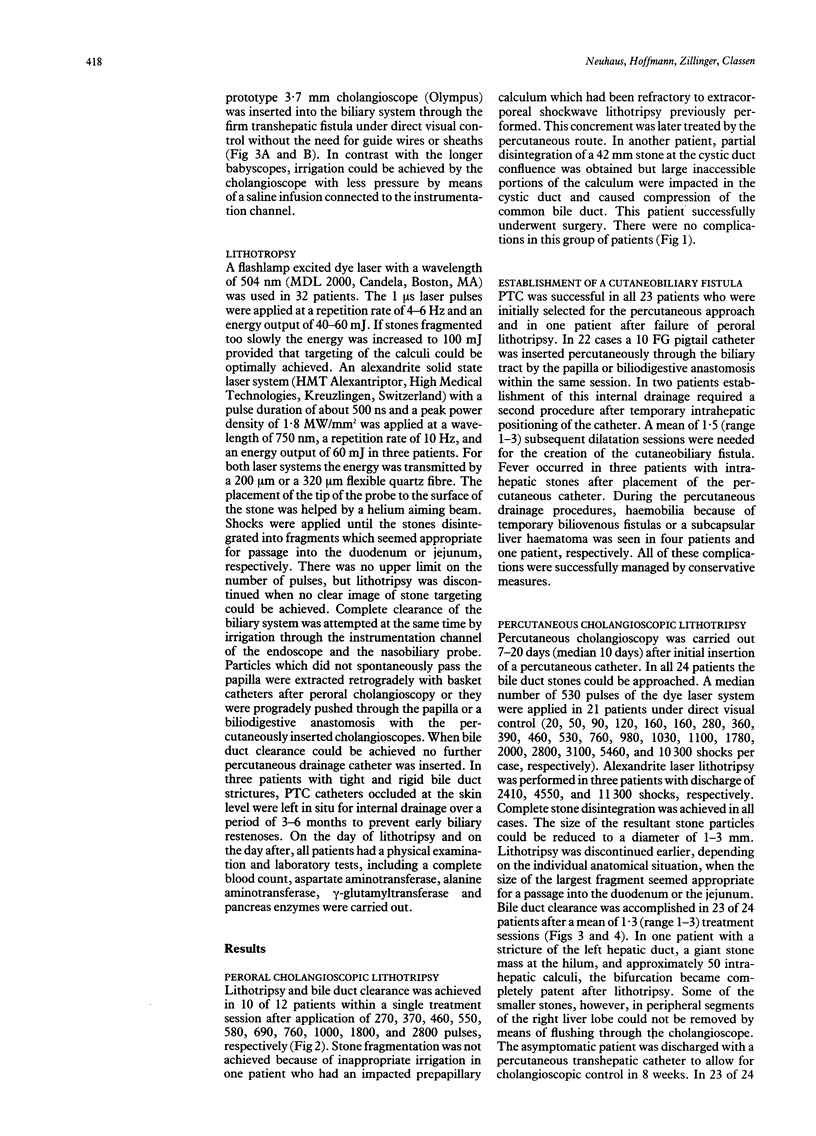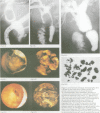Abstract
Biliary laser lithotripsy was performed under direct visual control in 35 consecutive patients not amenable to routine endoscopy. The patients had 1-50 (median 1) bile duct stones with the greatest diameter of the largest stone being 9-42 mm (median 20 mm). Conventional endoscopic treatment had failed because of an inaccessible papilla (16 patients), biliary strictures (seven patients), and impaction or large size of calculi (12 patients). Twelve patients, depending on their anatomical condition, underwent peroral cholangioscopy by means of a mother-babyscope system. Percutaneous cholangioscopy was initially carried out in 23 patients, 7-20 days (median 10 days) after creation of a transhepatic fistula. Pulsed dye laser (32 patients) or alexandrite laser (three patients) lithotripsy was applied under an appropriate direct visual control in all cases. Complete stone disintegration succeeded in 33 of 35 patients. All resultant fragments passed the papilla within a mean number of 1.3 treatment sessions. Peroral cholangioscopic lithotripsy failed in two cases. One patient successfully underwent percutaneous laser treatment and the other patient was referred to surgery. Fever, temporary haemobilia, or a subcapsular liver haematoma were seen in a total of eight patients during establishment of the cutaneobiliary fistula. A 95 year old patient who had been admitted with septic cholangitis died because of cardiorespiratory failure 5 days after bile duct clearance. It is concluded that laser lithotripsy performed under a direct visual control is an effective and safe procedure for the non-surgical treatment of difficult bile duct stones. Ductal clearance can usually be achieved in a single treatment session when the papilla and the stones are accessible by the peroral route. Percutaneous cholangioscopic lithotripsy is more time consuming but highly effective even in patients with a difficult anatomy, bile duct strictures, or intrahepatic calculi. This approach should be limited, however, to cases not amenable to retrograde procedures because the creation of the cutaneobiliary fistula is not without risks.
Full text
PDF






Images in this article
Selected References
These references are in PubMed. This may not be the complete list of references from this article.
- Bland K. I., Jones R. S., Maher J. W., Cotton P. B., Pennell T. C., Amerson J. R., Munson J. L., Berci G., Fuchs G. J., Way L. W. Extracorporeal shock-wave lithotripsy of bile duct calculi. An interim report of the Dornier U.S. Bile Duct Lithotripsy Prospective Study. Ann Surg. 1989 Jun;209(6):743–755. doi: 10.1097/00000658-198906000-00012. [DOI] [PMC free article] [PubMed] [Google Scholar]
- Bogan M. L., Hawes R. H., Kopecky K. K., Goulet R. J., Jr Percutaneous cholecystolithotomy with endoscopic lithotripsy by using a pulsed-dye laser: preliminary experience. AJR Am J Roentgenol. 1990 Oct;155(4):781–784. doi: 10.2214/ajr.155.4.1975984. [DOI] [PubMed] [Google Scholar]
- Bonnel D. H., Liguory C. E., Cornud F. E., Lefebvre J. F. Common bile duct and intrahepatic stones: results of transhepatic electrohydraulic lithotripsy in 50 patients. Radiology. 1991 Aug;180(2):345–348. doi: 10.1148/radiology.180.2.2068295. [DOI] [PubMed] [Google Scholar]
- Chen M. F., Jan Y. Y. Percutaneous transhepatic cholangioscopic lithotripsy. Br J Surg. 1990 May;77(5):530–532. doi: 10.1002/bjs.1800770519. [DOI] [PubMed] [Google Scholar]
- Classen M., Hagenmüller F., Knyrim K., Frimberger E. Giant bile duct stones--non-surgical treatment. Endoscopy. 1988 Jan;20(1):21–26. doi: 10.1055/s-2007-1018119. [DOI] [PubMed] [Google Scholar]
- Cotton P. B. Endoscopic management of bile duct stones; (apples and oranges). Gut. 1984 Jun;25(6):587–597. doi: 10.1136/gut.25.6.587. [DOI] [PMC free article] [PubMed] [Google Scholar]
- Cotton P. B., Kozarek R. A., Schapiro R. H., Nishioka N. S., Kelsey P. B., Ball T. J., Putnam W. S., Barkun A., Weinerth J. Endoscopic laser lithotripsy of large bile duct stones. Gastroenterology. 1990 Oct;99(4):1128–1133. doi: 10.1016/0016-5085(90)90634-d. [DOI] [PubMed] [Google Scholar]
- Ell C., Wondrazek F., Frank F., Hochberger J., Lux G., Demling L. Laser-induced shockwave lithotripsy of gallstones. Endoscopy. 1986 May;18(3):95–96. doi: 10.1055/s-2007-1018340. [DOI] [PubMed] [Google Scholar]
- Harrison J., Morris D. L., Haynes J., Hitchcock A., Womack C., Wherry D. C. Electrohydraulic lithotripsy of gall stones--in vitro and animal studies. Gut. 1987 Mar;28(3):267–271. doi: 10.1136/gut.28.3.267. [DOI] [PMC free article] [PubMed] [Google Scholar]
- Hill J., Martin D. F., Tweedle D. E. Risks of leaving the gallbladder in situ after endoscopic sphincterotomy for bile duct stones. Br J Surg. 1991 May;78(5):554–557. doi: 10.1002/bjs.1800780512. [DOI] [PubMed] [Google Scholar]
- Jeng K. S., Chiang H. J., Shih S. C. Limitations of percutaneous transhepatic cholangioscopy in the removal of complicated biliary calculi. World J Surg. 1989 Sep-Oct;13(5):603–610. doi: 10.1007/BF01658880. [DOI] [PubMed] [Google Scholar]
- Koch H., Stolte M., Walz V. Endoscopic lithotripsy in the common bile duct. Endoscopy. 1977 May;9(2):95–98. doi: 10.1055/s-0028-1098497. [DOI] [PubMed] [Google Scholar]
- Kopecky K. K., Hawes R. H., Bogan M. L., Griffith S. L., Dreesen R. G., Ulbright T. M. Percutaneous pulsed-dye laser lithotripsy of gallbladder stones in swine. Invest Radiol. 1990 Jun;25(6):627–630. doi: 10.1097/00004424-199006000-00002. [DOI] [PubMed] [Google Scholar]
- Kozarek R. A., Low D. E., Ball T. J. Tunable dye laser lithotripsy: in vitro studies and in vivo treatment of choledocholithiasis. Gastrointest Endosc. 1988 Sep-Oct;34(5):418–421. doi: 10.1016/s0016-5107(88)71408-x. [DOI] [PubMed] [Google Scholar]
- Lee S. H., Fache J. S., Burhenne H. J. The value of extracorporeal shock-wave lithotripsy in the management of bile duct stones. AJR Am J Roentgenol. 1990 Oct;155(4):775–779. doi: 10.2214/ajr.155.4.2119107. [DOI] [PubMed] [Google Scholar]
- Mo L. R., Hwang M. H., Yueh S. K., Yang J. C., Lin C. Percutaneous transhepatic choledochoscopic electrohydraulic lithotripsy (PTCS-EHL) of common bile duct stones. Gastrointest Endosc. 1988 Mar-Apr;34(2):122–125. doi: 10.1016/s0016-5107(88)71276-6. [DOI] [PubMed] [Google Scholar]
- Murray A., Basu R., Fairclough P. D., Wood R. F. Gallstone lithotripsy with the pulsed dye laser: in vitro studies. Br J Surg. 1989 May;76(5):457–460. doi: 10.1002/bjs.1800760511. [DOI] [PubMed] [Google Scholar]
- Neoptolemos J. P., Carr-Locke D. L., Fossard D. P. Prospective randomised study of preoperative endoscopic sphincterotomy versus surgery alone for common bile duct stones. Br Med J (Clin Res Ed) 1987 Feb 21;294(6570):470–474. doi: 10.1136/bmj.294.6570.470. [DOI] [PMC free article] [PubMed] [Google Scholar]
- Neoptolemos J. P., Hofmann A. F., Moossa A. R. Chemical treatment of stones in the biliary tree. Br J Surg. 1986 Jul;73(7):515–524. doi: 10.1002/bjs.1800730703. [DOI] [PMC free article] [PubMed] [Google Scholar]
- Neuhaus H., Hoffmann W., Classen M. Laser lithotripsy of pancreatic and biliary stones via 3.4 mm and 3.7 mm miniscopes: first clinical results. Endoscopy. 1992 Mar;24(3):208–214. doi: 10.1055/s-2007-1010464. [DOI] [PubMed] [Google Scholar]
- Nishioka N. S., Levins P. C., Murray S. C., Parrish J. A., Anderson R. R. Fragmentation of biliary calculi with tunable dye lasers. Gastroenterology. 1987 Aug;93(2):250–255. doi: 10.1016/0016-5085(87)91010-9. [DOI] [PubMed] [Google Scholar]
- Ponchon T., Gagnon P., Valette P. J., Henry L., Chavaillon A., Thieulin F. Pulsed dye laser lithotripsy of bile duct stones. Gastroenterology. 1991 Jun;100(6):1730–1736. doi: 10.1016/0016-5085(91)90676-c. [DOI] [PubMed] [Google Scholar]
- Sauerbruch T., Stern M. Fragmentation of bile duct stones by extracorporeal shock waves. A new approach to biliary calculi after failure of routine endoscopic measures. Gastroenterology. 1989 Jan;96(1):146–152. doi: 10.1016/0016-5085(89)90775-0. [DOI] [PubMed] [Google Scholar]
- Schmeller N., Kriegmair M., Liedl B., Hofstetter A., Muschter R., Thomas S., Knipper A. Laserlithotripsie mit automatischer Abschaltung bei Gewebekontakt. Urologe A. 1990 Nov;29(6):309–312. [PubMed] [Google Scholar]
- Schmitt W., von Sanden H., Wegerle W., Ottenjann R. Perorale und transhepatische Cholangioskopie. Leber Magen Darm. 1991 May;21(3):116, 119-20, 122-4. [PubMed] [Google Scholar]
- Staritz M., Rambow A., Grosse A., Hurst A., Floth A., Mildenberger P., Goebel M., Junginger T., Hohenfellner R., Thelen M. Electromagnetically generated extracorporeal shockwaves for fragmentation of extra-and intrahepatic bile duct stones: indications, success and problems during a 15 months clinical experience. Gut. 1990 Feb;31(2):222–225. doi: 10.1136/gut.31.2.222. [DOI] [PMC free article] [PubMed] [Google Scholar]
- Strunge C., Brinkmann R., Flemming G., Engelhardt R. Interspersion of fragmented fiber's splinters into tissue during pulsed alexandrite laser lithotripsy. Lasers Surg Med. 1991;11(2):183–187. doi: 10.1002/lsm.1900110213. [DOI] [PubMed] [Google Scholar]
- Yoshimoto H., Ikeda S., Tanaka M., Matsumoto S., Kuroda Y. Choledochoscopic electrohydraulic lithotripsy and lithotomy for stones in the common bile duct, intrahepatic ducts, and gallbladder. Ann Surg. 1989 Nov;210(5):576–582. doi: 10.1097/00000658-198911000-00002. [DOI] [PMC free article] [PubMed] [Google Scholar]





